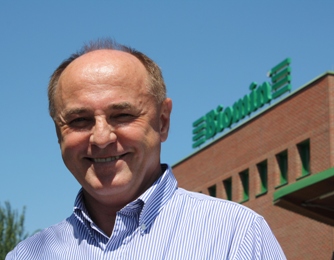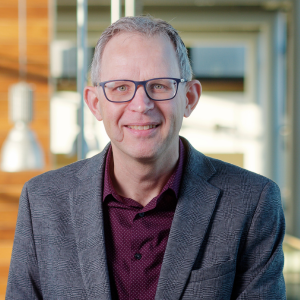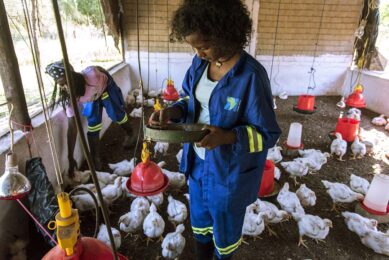“We will be able to feed nine billion people in 2050”

Being an entrepreneur in the feed industry, one needs a unique mix of optimism, curiosity and perseverance. Pioneering in the field of natural feed additives, like probiotics and mycotoxin deactivation, Erich Erber, founder of Biomin, is like walking a road which is full of trial and error. Nothing, however, could take away the focus of delivering innovative products.
By Vincent ter Beek
“It was just great fun, to create something new. In the early eighties, the use of antibiotics was the standard – everybody was using them. When I started in the industry, animal performance growth was 10-15%. Ten years later, however, the performance increase was down to 3-4%. So the decline of the efficacy was obvious and to just increase the dosing was not a solution for the long term. It was quite clear to me that antibiotics would not have a sustainable impact in the future. My feeling from practical experience was: We needed something new.
My friend Dr Herbert Egger was the first, in the early eighties, to produce probiotics, on a very small scale. His product was called Pronifer and consisted of microbials isolated from rumen. I got to know him quite well as his distributor. He indeed was one of the pioneers in the field of probiotics and lactic-acid bacteria. However, when selling the probiotic to several feedmillers initially, it wasn’t a continuous success and we had to try to find out why the product had failed. Looking into it, there was always something new to be learned, the formulation, the right stability, or many other things, such as that one cannot combine probiotics with certain antibiotics for example. Finally when I decided to start my own company, I created a premix product line with the probiotics of Dr Egger in it. Luckily it went well – today we are even selling in Korea, the most competitive probiotic market in the world.”
History
“I am a farmer’s son, my family were animal traders. I had to help on the trade from a very early age. I studied agricultural engineering – also doing an internship in Canada, where I got to know large scale farming for the first time. When starting up my own company in Austria in 1983, I came up with the idea to call the company after ‘biological minerals’ – bio-min. Afterwards it became clearer to me that I wanted to make a product line that is purely probiotic.
“I am a farmer’s son, my family were animal traders. I had to help on the trade from a very early age. I studied agricultural engineering – also doing an internship in Canada, where I got to know large scale farming for the first time. When starting up my own company in Austria in 1983, I came up with the idea to call the company after ‘biological minerals’ – bio-min. Afterwards it became clearer to me that I wanted to make a product line that is purely probiotic.
In 1985, we bought Interpremix, a small premix factory which became our first production facility. The founder, Dr Halama, had been one of the first to think about a product that can adsorb or deactivate mycotoxins – and had a toxin adsorbing product which was branded Antitox Plus. At first, looking at the formula, I couldn’t think that this product was of any purpose.
Halama, who stayed on as a consultant, had however been able to convince a Taiwanese business man to become a distributor of this product. We shipped a container and I thought they would never order again. But suddenly, we got another order from Taiwan. It made me think: Why are the Taiwanese using a product that should not be effective? I went to Prof Leibetseder at the Veterinary University in Vienna and asked if they could do some in vitro studies on the product. Finally, after we saw the results, I was stunned. For deoxynivalenol (DON) and ZON, common in Europe, it was zero. But aflatoxins, which are abundant in Taiwan, the efficacy was 98%.”
Deactivation
“At that time, when farmers in Europe were faced with corn silage with DON, the recommendation was: Feed it to the bull, as he can cope with it, there was never any growth retardation. I wondered, why can a bull deal with it? There must be some kind of mechanism in the rumen that can either decompose or make use of this molecule. So when we started our own research team in Tulln, Austria, we designed an artificial rumen model to find out what detoxification mechanism takes place in the rumen fluid. Eventually we identified a microbe that was able to detoxify DON and other members of the trichothecene family. The result was BBSH, a Eubacteriumstrain ‘new to the world’, found in 1997.
The registration of any product for mycotoxins deactivation in the EU proved very difficult since there was no classification in the EU for this kind of feed additives until recently. The European Food Safety Authority (EFSA) had more or less the view of: Everything above the maximum mycotoxin regulation level must not be used as a feed ingredient. So in Europe, nobody is allowed to blend or dilute the contaminated feed – we simply had to burn it. Now, finally, there is a category where the products for mycotoxin deactivation can be put in: As a product with a claim to both deactivate mycotoxins and to bind mycotoxins. We expect first ruling on the EU feed registration law by the end of this year or early next year.”
Probiotics
“Probiotics or natural growth promoters in general have a bad image. Often I hear: If they are so good, why didn’t they cover the market yet? I think the answer is very simple. Antibiotic growth promoters have been existing for 40-50 years, and had a large R&D behind it. Besides, most AGPs have been developed for veterinary or human use and the pharma industry had its product applications expanded into the feed industry. If we develop a probiotic now like PoultryStar or AquaStar solely for the feed industry, we have to pay not only for R&D cost to develop such products, but also have to go through all the registration and other regulatory hurdles for just one possible market: The feed industry.
“Probiotics or natural growth promoters in general have a bad image. Often I hear: If they are so good, why didn’t they cover the market yet? I think the answer is very simple. Antibiotic growth promoters have been existing for 40-50 years, and had a large R&D behind it. Besides, most AGPs have been developed for veterinary or human use and the pharma industry had its product applications expanded into the feed industry. If we develop a probiotic now like PoultryStar or AquaStar solely for the feed industry, we have to pay not only for R&D cost to develop such products, but also have to go through all the registration and other regulatory hurdles for just one possible market: The feed industry.
Taking the probiotics as an example we are still in really early stages. Only now, with the ban of AGP ongoing in Europe, Korea and Taiwan – and China thinking about it – the industry will begin to invest millions in new product lines. Once when we get big spendings in new product lines, we can enhance better product formulations.”
2050
“I am very convinced we will be able to feed nine or ten billion people in 2050, if only we allow technology to develop what needs to be done, under a pretext of a stable political and war-free future. We can see that feed conversion rations in chickens have come down from 2.5 to 1.4 to 1.1, in pigs they have also come down. And the more expensive the feed becomes, the more interesting it becomes for the feed miller to use products that can enhance the feed conversion rations.
“I am very convinced we will be able to feed nine or ten billion people in 2050, if only we allow technology to develop what needs to be done, under a pretext of a stable political and war-free future. We can see that feed conversion rations in chickens have come down from 2.5 to 1.4 to 1.1, in pigs they have also come down. And the more expensive the feed becomes, the more interesting it becomes for the feed miller to use products that can enhance the feed conversion rations.
Humans are very innovative to overcome challenges and to improve, e.g. the genetics of the animals and the crops; the formulation of the feed additives; enzymes will help us use commodities that would otherwise not be utilisable in the feed ratio; and I am strong believer that GMO will help us overcome the feed shortages. All this hype in Europe about Frankenstein food is only because we are still lucky to have enough.”
Erich Erber, age 58, is the director of the Executive Board of the Erber Group, which consists of four divisions: · Biomin · Romer · Sanphar · Strategic Investments The four divisions work together to be a complete partner in the field of safe food production, from detection to control. The groups total sales is about €200 million; total number of employees exceeded 1,000 this year. Biomin is the major division within the Erber Group, taking about 80% of its total sales. The company is headquartered in Herzogenburg, Austria, with a large research laboratory in Tulln. At the moment, a new head office is being constructed to accommodate its growing number of employees in one location. Apart from Herzogenburg, the natural feed additive producer has regional headquarters in San Antonio, TX, USA as well as Singapore. Biomin alone has 47 business units. Its product lines include acidifiers, phytogenics, probiotics, preservation products and enzymes. The best-known product is Mycofix – a mycotoxin deactivator. |
Join 31,000+ subscribers
Subscribe to our newsletter to stay updated about all the need-to-know content in the poultry sector, three times a week. Beheer
Beheer








 WP Admin
WP Admin  Bewerk bericht
Bewerk bericht